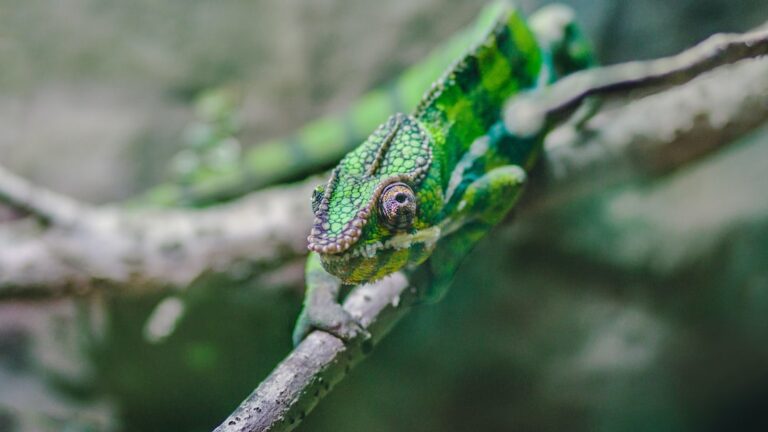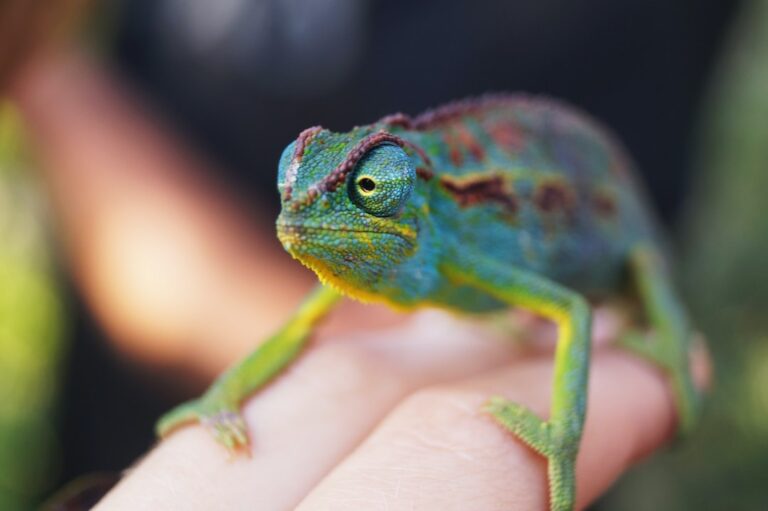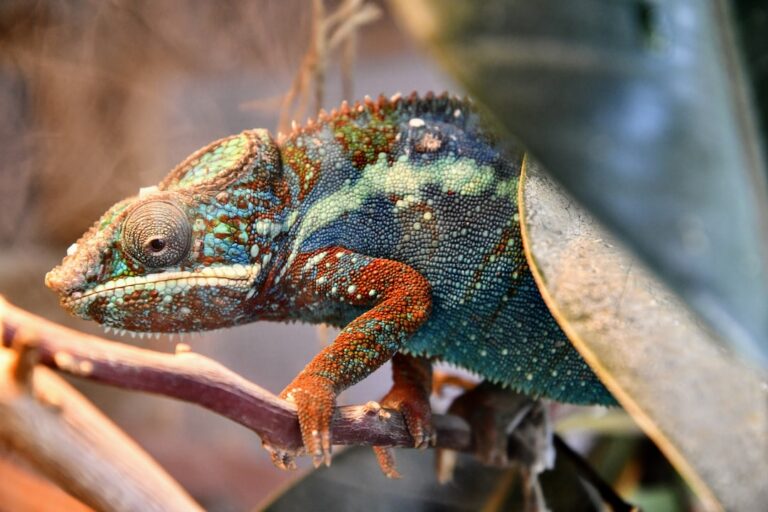Can Chameleons Survive In Cold Weather?
Chameleons are fascinating creatures known for their ability to change color and blend into their surroundings. They are native to warm and tropical regions, such as Africa, Madagascar, and parts of Asia and Europe. Chameleons are arboreal reptiles, meaning they spend most of their time in trees and bushes. They have specialized feet that allow them to grip onto branches and a long, prehensile tail that helps them maintain balance.
Understanding the natural habitat of chameleons is crucial for their survival. In the wild, they rely on specific environmental conditions to thrive. These conditions include temperature, humidity, access to food, and suitable shelter. By understanding these factors, we can better care for chameleons in captivity and ensure their well-being.
Table of Contents
The Effect of Temperature on Chameleons: How Cold Weather Affects Them
Temperature plays a vital role in the survival of chameleons. As ectothermic animals, they rely on external sources of heat to regulate their body temperature. Chameleons are most active and thrive in temperatures ranging from 70 to 90 degrees Fahrenheit (21 to 32 degrees Celsius). When temperatures drop below this range, chameleons become sluggish and may struggle to perform essential bodily functions.
Cold weather can have a significant impact on chameleons’ survival. In colder temperatures, their metabolism slows down, leading to reduced activity levels and decreased appetite. This can result in weight loss and weakened immune systems, making them more susceptible to diseases. Additionally, cold weather can cause respiratory issues in chameleons, as they struggle to breathe properly in low temperatures.
The Adaptability of Chameleons: Can They Survive in Cold Climates?
While chameleons are well-adapted to warm climates, they are not naturally equipped to survive in cold climates. Their physiology and behavior are not suited to withstand extreme cold temperatures. Chameleons lack the ability to generate internal heat, which means they rely on external heat sources to warm their bodies.
In cold climates, chameleons face numerous challenges. They may struggle to find suitable shelter and may not have access to enough food to sustain themselves. Additionally, their bodies are not designed to handle prolonged exposure to cold temperatures, which can lead to health issues and even death.
The Physiology of Chameleons: How They Regulate Their Body Temperature
Chameleons have several physiological adaptations that help them regulate their body temperature. One of the most notable adaptations is their ability to change color. By changing color, chameleons can absorb or reflect sunlight, which helps them warm up or cool down as needed.
Chameleons also have specialized skin that allows them to absorb heat from their surroundings. Their skin contains dark pigments that absorb sunlight and convert it into heat energy. They can also flatten their bodies and expose more surface area to the sun, maximizing heat absorption.
Additionally, chameleons have a unique circulatory system that helps distribute heat throughout their bodies. They have large blood vessels close to the surface of their skin, allowing them to quickly transfer heat from their skin to their internal organs.
The Importance of Humidity for Chameleons: How It Impacts Their Survival in Cold Weather
Humidity is another crucial factor for chameleons’ survival, especially in cold weather. Chameleons require a certain level of humidity in their environment to maintain proper hydration and respiratory function. In low humidity conditions, chameleons can become dehydrated and may struggle to shed their skin properly.
In cold climates, maintaining humidity levels can be challenging. Cold air tends to be drier, which can lead to dehydration in chameleons. Providing a humid environment for chameleons in cold weather can be achieved through the use of misting systems, humidifiers, or by placing a water source near their enclosure.
The Role of Shelter for Chameleons: How It Helps Them Survive in Cold Weather
Shelter is crucial for chameleons’ survival in cold weather. In their natural habitat, chameleons seek out sheltered areas such as dense foliage or tree hollows to protect themselves from extreme temperatures. These sheltered areas provide insulation and help maintain a more stable microclimate.
In captivity, providing suitable shelter for chameleons is essential. This can be achieved by creating a well-designed enclosure that includes hiding spots, branches, and foliage. These elements not only provide shelter but also mimic the natural habitat of chameleons, promoting their overall well-being.
The Impact of Food Availability on Chameleons: How It Affects Their Ability to Survive in Cold Weather
Food availability is another critical factor that affects chameleons’ ability to survive in cold weather. In colder climates, the availability of insects, which are the primary food source for chameleons, may be limited. This can lead to malnutrition and weakened immune systems.
To ensure the survival of chameleons in cold weather, it is essential to provide a varied and nutritious diet. This can include a combination of live insects, such as crickets and mealworms, as well as gut-loaded insects that have been fed a nutritious diet before being offered to the chameleon.
The Role of Artificial Heating for Chameleons: How It Can Help Them Survive in Cold Weather
Artificial heating plays a crucial role in helping chameleons survive in cold weather. By providing supplemental heat sources, such as heat lamps or ceramic heat emitters, chameleons can maintain their body temperature within the optimal range.
When using artificial heating, it is important to create a thermal gradient within the enclosure. This means providing a warm basking spot where the chameleon can raise its body temperature and a cooler area where it can retreat to if it becomes too warm. This allows the chameleon to regulate its body temperature as needed.
Tips for Keeping Chameleons in Cold Climates: How to Ensure Their Survival
Keeping chameleons in cold climates requires careful attention to their environmental needs. Here are some tips to ensure their survival:
1. Provide a well-insulated enclosure: Use materials that provide insulation, such as glass or acrylic, to help maintain a stable temperature within the enclosure.
2. Use supplemental heating: Install heat lamps or ceramic heat emitters to provide a warm basking spot for the chameleon.
3. Maintain proper humidity levels: Use misting systems or humidifiers to ensure adequate humidity levels in the enclosure.
4. Offer a varied and nutritious diet: Provide a combination of live insects and gut-loaded insects to ensure the chameleon receives proper nutrition.
5. Monitor temperature and humidity levels: Use thermometers and hygrometers to regularly monitor the temperature and humidity within the enclosure.
Can Chameleons Survive in Cold Weather? The Final Verdict.
In conclusion, while chameleons are not naturally equipped to survive in cold climates, with proper care and attention, they can thrive in captivity even in colder regions. Understanding their natural habitat, including temperature, humidity, shelter, and food requirements, is crucial for their survival.
By providing suitable shelter, maintaining proper humidity levels, offering a varied diet, and using artificial heating, chameleons can be kept healthy and comfortable in colder climates. However, it is important to closely monitor their environment and make adjustments as needed to ensure their well-being.
Overall, while chameleons may not be able to survive in the wild in cold weather, with proper care and attention, they can adapt and thrive in captivity even in colder regions.
If you’re interested in reptiles, you might also enjoy reading the article “Can Iguanas Eat Meat?” on Reptile Friend. It explores the dietary habits of iguanas and whether or not they can consume meat. It’s a fascinating topic that delves into the nutritional needs of these unique creatures. Check it out here!







